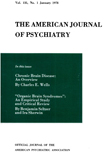Biofeedback in the treatment of blepharospasm: a case study
Abstract
Although biofeedback has been of value in treating spastic paresis and torticollis, its effectiveness in other movement disorders is less clear. Blepharospasm, which has no definitive treatment, often has a strong psychogenic component. The authors report the use of electromyographic and temperature biofeedback in a women with blepharospasm who had responded poorly to psychotherapy. Her improvement during biofeedback treatment further elucidated psychogenic factors contributing to the disorder. At 3-months follow-up it seemed that the patient's secondary gain from the blepharospasm diminished the maximum treatment response she could have had to biofeedback.
Access content
To read the fulltext, please use one of the options below to sign in or purchase access.- Personal login
- Institutional Login
- Sign in via OpenAthens
- Register for access
-
Please login/register if you wish to pair your device and check access availability.
Not a subscriber?
PsychiatryOnline subscription options offer access to the DSM-5 library, books, journals, CME, and patient resources. This all-in-one virtual library provides psychiatrists and mental health professionals with key resources for diagnosis, treatment, research, and professional development.
Need more help? PsychiatryOnline Customer Service may be reached by emailing [email protected] or by calling 800-368-5777 (in the U.S.) or 703-907-7322 (outside the U.S.).



